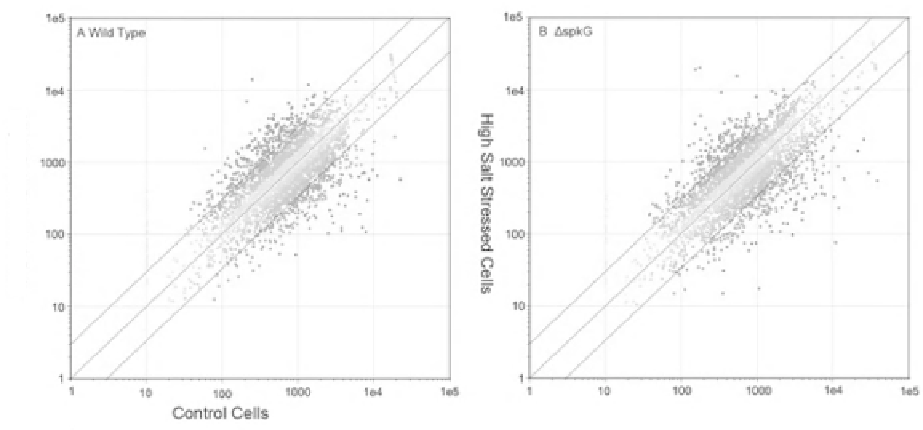Biology Reference
In-Depth Information
10
5
10
5
B ΔspkG
A
Wild Type
10
4
10
4
1000
1000
100
100
10
10
1
1
1
10
100
1000
10
4
10
5
1
10
100
1000
10
4
10
5
Control Cells
Control Cells
Figure 10:
Genome-wide patterns of transcription of salt-stress regulated genes. (A). Gene expression in wild-type cells that
had been exposed to 855 mM NaCl for 30 min was compared with that in unstressed cells. (B). Gene expression in mutant
spkG cells that had been exposed to 855 mM NaCl for 30 min was compared with that in unstressed cells. Dots correspond
to genes whose fold change >2 are beyond the reference lines. With the kind permission of S. Qin, Institute of Oceanology,
Chinese Academy of Sciences, Qingdao, China. [Liang
et al
. (2011)
PLoS ONE
6(5):
e18718. doi:10.1371/journal.pone.0018718]
doi:10.1371/journal.pone.0018718.g004.
Color image of this figure appears in the color plate section at the end of the topic.
tail, Hibino
et al
. (1999) conducted a comparative study of the activities of three different types of
DnaK1 molecules (DnaK1 from
A
.
halophytica
and
S. elongatus
PCC 7942 and the C-terminal tail
deleted DnaK1 from
A
.
halophytica
) produced in
E
.
coli
cells for their ATPase activity and refolding
activity of the urea-denatured proteins under salinity stress. The ATPase activity of DnaK1 was very
high at salinity levels of 1.0 M NaCl or KCl from
A
.
halophytica
but the ATPase activity of DnaK1
from
Synechococcus
decreased with increasing concentration of the salts. The deletion of C-terminal
tail of DnaK1 of
A
.
halophytica
had no apparent effect on ATPase activity but the refolding activity
of the DnaK1 protein is lost because it could not carry out the refolding of urea-denatured lactate
dehydrogenase at high salinity. These results emphasize the role of DnaK1 and its C-terminal region
in helping denatured proteins to overcome salt-stress (Hibino
et al
., 1999).
Computational screening of intergenic regions of
S. elongatus
PCC 6301 and its comparison with
three genomes of freshwater cyanobacteria brought to light the existence of small, regulatory, non-
coding RNA (ncRNA) genes. These ncRNAs are shown to be required for growth under multiple
stress conditions. One of these genes
Yfr1
is 65 nucleotides long and is located in between
gnaB
and
trxA
genes. This gene seems to be highly conserved among the genomes examined. Further, a
mutant of
S
.
elongatus
PCC 6301 defi cient in
Yfr1
was unable to tolerate various stress conditions
such as oxidative stress and salt stress and showed accumulation of the transcripts of
sbtA
gene.
In vitro
interaction of Yfr1 RNA with
sbtA
mRNA suggests that the target of action of Yfr1 is
sbtA
mRNA (Nakamura
et al
., 2007).
Gaber
et al
. (2007) identifi ed two genes (slr1562 and ssr2061) in the genome of
Synechocystis
sp.
strain PCC 6803 that encode two glutaredoxins (Grxs), Grx1 and Grx2 respectively. The deduced
amino acid sequences of these are highly homologous to the Grxs from other organisms. Grxs are









